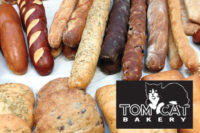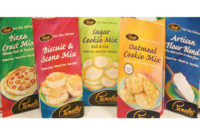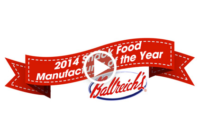
By Dan Malovany
New Yorkers tend to be proud, demanding, sometimes stubborn and often opinionated, or so their reputations go. Heck, they don’t call it the Big Apple for nothing. As far as they are concerned, there’s the World Champion Yankees and the rest of baseball. There’s New York City and the rest of the world.
Then there are New York chefs, some of who are celebrities and others who think they are. When it comes to the food they serve, there’s the best and the rest.
That makes them the perfect type of customers for Tom Cat Bakery, whose production crew members create an array of artisan breads, breakfast items and premium sweet goods and pride themselves on being bakers who think like chefs.
“Our goal in life is to make authentic breads that are better than the breads you get in Western Europe,” says Matthew Reich, president of the Long Island City, N.Y.-based bakery. “We never have made any compromises on quality at the expense of production efficiencies or shelf-life efficiencies.”
Product authenticity, he adds, is the linchpin to producing such quality breads and rolls.
“To make an authentic baguette, for instance, you need a preferment and long proofing time to develop the flavor followed by proper baking time to develop a real crust,” Reich explains. “To me, it’s all about the desire to make an authentic product rather than something that is commercially salable for two or three days at a time. A baguette has a shelf life of eight hours so when people sell baguettes in supermarkets and they have a two or three day shelf life, why are you even calling it a baguette?”
Likewise, Tom Cat Bakery’s hamburger buns are anything but ordinary. In fact, the premium buns it sells are actually a brioche with lots of butter. Although there is still a demand among more casual dining restaurants for conventional hamburger and hot dog buns, Reich notes, there is no room for cutting corners among New York’s finer establishments.
“Our hamburger bun sells for about 60 cents at wholesale,” he says. “It’s like $7 a dozen for [our] hamburger buns. However, the guy who is buying our buns sells the hamburgers for $12.95. In the places we serve in New York, there are no $4.99 sandwiches. They are way north of that.”
Service and flexibility are the two other cornerstones of the Tom Cat Bakery value proposition. Its 35-route system, for instance, consists of 27 trucks that make 750 to 800 deliveries a day to service its core customers within a 150-mile radius of its bakery in Queens. They include some of metropolitan New York’s top hotels and fine-dining restaurants and steakhouses, as well as specialty retail stores and upscale sandwich chains. During the summer months, Reich notes, business booms throughout Long Island as Manhattan residents flock to their second homes and resorts along the shore.
In addition to 365-day-a-year delivery, several major accounts routinely receive three deliveries a day starting at 5 a.m. with breakfast items such as fresh scones, Danish, muffins and croissants along with shipments of afternoon sweets and its signature baguettes, boules and other artisan breads and rolls for lunch and dinner.
“From the top down, it is all about the customer,” Reich says. “If the baguettes aren’t right, we’re going to remake them and ship them later at our own expense. If we mess up, we’ll do anything possible to get the customer what they need, and if they make a wrong order, we’ll make it good. If customers don’t order, we’ll call them or ship it anyway because they may have forgotten to put some items on their order. That’s an expensive part of our culture, but an important one.”
With its 275 employees, of which 180 work in production, the bakery can handle all sizes of orders, including those products that need special handmade touches. Made-to-order, Reich says, is often the price of entry in the highly competitive New York market. That’s why the bakery produces more than 400 different products.
“For foodservice clients and restaurants, we’ll get requests for five different types of rolls,” he notes. “They’ll want four dozen of one and 25 dozen of the other rolls. As a result, most of the packaging is done by hand.”
For national accounts, he notes, Tom Cat Bakery offers frozen versions of its most popular varieties of artisan breads and rolls that have been developed for such celebrity chefs as Le Bernardin and Jean Georges, as well as frozen sweets such as gourmet cookies and bars. Despite the increasing popularity of frozen baked goods by many labor-challenged foodservice operators and in-store bakeries, sales of fresh products outpaced frozen in 2009 and continue to remain the main focus for the company going forward. In fact, fresh deliveries still account for about 85% of its business, which is about $32 million in annual sales. That’s partly because of the unique idiosyncrasies of the New York market and the company’s strategic focus on being the best regional bakery in the metropolitan area.
“Five years from now, where do I want to be? Maybe 20% frozen bread and 80% fresh bread,” Reich says. “Others like frozen because you can automate it and distribute it. In the New York metro area, the foodservice industry doesn’t use frozen bread. They do not have the freezer space. It’s just too expensive, and there is a good variety of fresh bread that can be delivered daily by some really good bakers.”
The Chef’s Best Friend
That hasn’t always been the case. In fact, it was the lack of high-quality bread that prompted Noel Labat-Comess to start up Tom Cat Bakery in 1987. A former chef at a four-star restaurant and a cat lover, thus accounting for the bakery’s name, he decided to take his formulas and begin baking what he felt was the best bread in the city for a fistful of high-end restaurants, notes James Rath, vice president of manufacturing and R&D.
Rath, a former aerospace worker was hired by Labat-Comess a year after the bakery was started, continues to serve as the head baker as well as the heart and soul of production, which continues today to rely on a variety of traditional sours and starters, along with long fermentation times, to create Old World breads and rolls.
Reich also is a veteran of the company. The founder of New Amsterdam Brewery and former chief operating officer of Terra Chips, Reich sold beer to Labat-Comess when he was a chef, then later served as a sales and marketing consultant to Tom Cat Bakery before being hired as chief operating officer in 1994.
“He realized it was cheaper to hire me as the chief operating officer than to pay me as a consultant,” Reich says.
Since then, Reich and Rath built the infrastructure for the semi-automated bakery, which experienced double-digit growth from $3 million in 1995 to more than 10 times that in 2008. During the past decade, for instance, they assembled an experienced, 12-person management team that now oversees day-to-day sales and operations. When Labat-Comess decided to retire in 2008, they partnered with the private equity firms of Ancor Capital Partners of Dallas and Merit Capital Partners of Chicago, both of which invest in small-cap companies with annual sales ranging between $25 and $150 million.
“We liked how they view an investment,” Reich says. “There is no timeframe such as we’re going to be in this deal for three years and flip it. They have been with companies for as long as 12 years.”
Working with its private equity partners, Tom Cat Bakery has sought out synergies and outlined new opportunities for the changing economic landscape. Since the collapse of Lehman Brothers in October 2008, the foodservice market has declined, resulting in a 30% drop in tradeshow attendance and tough times for many of Tom Cat Bakery’s core customers. Reich acknowledges that 2009 was an unusually tough year. Some of the bakery’s customers have gone out of business while others have traded down, he says, but Tom Cat Bakery has held its own by stepping up the responsiveness of its customer service and offering greater product flexibility, even among smaller orders.
Fortunately, the bakery’s new partners understand the realities of the new world order.
“It could have been really tense because we can’t control the world economy,” Reich says. “They were very understanding that our customer base was having big problems. They said, ‘You guys develop a strategy on what’s the best way to deal with this.’”
To control costs, for instance, Ancor teamed up Tom Cat Bakery with one of its other investments, Fleischer’s Bagels of Rochester, N.Y., and the two bakeries now share a chief financial officer and IT functions to control costs.
“They had the idea that we could share some resources with them, and we actually do,” Reich says.
For revenue generation, Tom Cat Bakery’s new strategic plan involves expanding with branded products into the retail channel, which it historically had avoided because the bakery is structured in terms of customer service, sales and distribution to service a much different foodservice customer base.
“Consumer-branded marketing is a whole different distribution channel with its execution and different expense base with sales and with servicing of the stores,” Reich says.
Consumers, however, recognize the Tom Cat brand having seen the “iconic” route trucks with the bakery’s signature logo constantly serving hotels, shops and restaurants throughout New York, he says.
That logo is now the calling card on its bread bags and special rack displays.
With the new retail venture and the economy recently indicating a slow turnaround, the bakery is looking to expand its operation to bolster its warehouse and packaging capabilities. The strategy for growth now involves market penetration in the foodservice arena while making roads in the retail channel.
For Tom Cat Bakery, flexibility is the secret to having nine lives in the baking industry.
“We’re going to do what’s best, which is making artisan bread, and sell it to foodservice customers,” Reich says. “At the same time, we’re going to start developing a Tom Cat retail brand because in New York City, we’re still well-known.”
That’s because New Yorkers and its most demanding chefs consider their products the cat’s meow.





